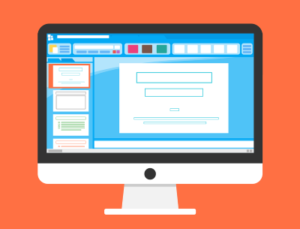How to Make An Effective Slide Presentation for Your Church
Using slide presentation media can be intimidating for some pastors and worship leaders because they are afraid it will become a distraction. While this may be a valid concern, creating effective slide presentations is not as difficult or time-consuming as many people may think. No matter what kind of software or platform you decide to use, this article includes 7 tips you can use to make your presentation more effective for your church.
Visual presentations during a sermon or worship time can be really helpful and can enhance the teaching, but they can also be distracting and take away from the lesson if used incorrectly.
To help you make a more effective slide presentation, here are 7 tips to incorporate:
- Pick colors wisely
- Choose an easy-to-read font
- Don’t use distracting transitions or animations
- Disable screen savers and pop-ups
- Use attractive, simple backgrounds
- Add some images and shapes to the text
- Don’t overdo it

Visual aids like slide powerpoints should never be the main focus of your church presentation, they should simply be an “aid” to help emphasize the lesson. Let’s dive into each of these points and talk about why an effective presentation can make an impact on your church.
1. Pick Colors Wisely
Depending on the size of your church, the lighting, and where the screens are located, you want to be sure to pick colors that allow for easy viewing of the presentation. There should be a contrast between the background of the presentation and the text. If there is a dark background, choose a light text color and vice versa.
Remember that with a church presentation, you are not going for fancy and super creative – you want it to complement the lesson in a way that is not distracting, but still adds an impact.
Something that may help you when you are creating the presentation is to test different backgrounds and text colors to see how they appear in the sanctuary.
2. Choose An Easy-to-Read Font
What may be easy to read on a computer screen when you’re creating your presentation, may not be so easy to read on a large backdrop. Choosing a font style and size that allows for easy reading is important for your congregation and helps them follow along without getting behind.
Try to pick something that is sans-serif, simple (not cursive or decorative), at least 32 pt. minimum. If you are wanting to emphasize a certain point, you can bold or italicize, but remember to do so sparingly as it can make it harder to read.
As always, test out your presentation before you use it to be sure anyone in the congregation would be able to read and understand what is on the slide.
3. Don’t Use Distracting Transitions or Animations
Unlike school presentations where creativity is helpful, be cautious not to use any cheesy slide transitions or animations. When talking about certain subjects, these devices can be very distracting and take away from the message at hand.
There are rare occurrences where using a transition or animation may help to emphasize a certain point or help as you move on to another section – just be cautious and test it out before presenting.
Oftentimes, if presentations are being used as note-taking guides, transitions can mess up the timing and people will miss the point you are trying to make, keep in mind when working on your lesson.
4. Disable Screen Saver and Pop-Ups
When in the middle of your lesson, having the screen go black or a pop-up appear is extremely distracting and can break up the flow of the presentation in a negative way. Research how to disable the screen saver feature on your computer and disable any anti-virus programs from allowing pop-ups on your screen – it’s often very simple.
While you are eliminating these distractions, you should also check on the status of your projector. Sometimes they can go to sleep or get overheated during a presentation so timing when you turn it on and how long the presentation maybe is just as important as disabling the screen saver and pop-ups.
5. Use Attractive, Simple Backgrounds
It can be hard to pick a background that seems boring or uninspiring – but it is often the best way to go. Similar to choosing a font and color, your background can help or hurt your presentation. Choosing a theme that makes your presentation flow together and “matches” will establish a focus and credibility.
You can either make your theme or choose from whatever software or platform you use (most of them have templates already created).
There are instances where having an image in the background, purposely faded and behind the text, is okay to use and won’t be distracting. If you choose to use something like this, be sure to test it out and make it go along with the lesson.

6. Add Some Images and Shapes to the Text – Sparingly
We have been talking about making a presentation that is focused, easy to read, and not distracting. However, adding certain images or shapes can help emphasize a certain point if used correctly and sparingly.
Most presentation software will have shapes and arrows, diagrams, etc. where you can insert your text in a way that is helpful to understand.
These illustrations are relatively easy to insert and can help give your presentation some organization, without being distracting. Just be sure to limit how many you include on one slide, or even one presentation – the text and lesson should still be the main focus.
7. Don’t Overdo It
Similar to how a teacher uses a PowerPoint for a lesson is how you should use one for your sermon. The presentation should not contain every word you will say during the lesson – it should simply act as an aid or a guide, making the most important points stand out.
You know your congregation, your audience, so you know what works best for them. Instead of trying to “jazz things up” or make a certain lesson more fun, keep it simple and direct, letting the lesson speak for itself.
The PowerPoint should only show the main context that you can expound upon while allowing your people to see the context/principle you are talking about at all times.
Trust yourself and your church members and know that any presentation only needs to be in the background, the scripture and lesson are the most important things to focus on.
Why Should I Use a Slide Presentation for My Church?
Depending on your church, as well as your style as a pastor or church leader, slide presentations may be a more effective way of engaging your audience. Many churches use slide presentations as guides for people who take notes – this can keep people focused and help them understand the purpose of the lesson.
Slide presentations can also be helpful for you as the presenter – they can help keep you organized and on-topic. Even if you veer off on a tangent for a minute, the presentation can help you come back to the main point.
In today’s society, we have experienced the need for easy access to technology, with slide presentations, you can make your sermon available to anyone at any time. By using a slide presentation, you can easily upload it to Facebook or your church’s website, and anyone who wasn’t able to make it to church can still see the lesson.
Understanding the important uses of a slide presentation and how to make effective one can truly enhance the lesson you are preaching about.

Related Questions
How Do You Use an Effective Presentation for Worship?
Finding software and a facilitator to conduct the presentation are the most important things to keep in mind when working on a worship presentation. Worship presentations will be a bit different than a sermon presentation because slides will need to be flipped back and forth according to verses, bridges, chorus, etc.
It may be a better idea to purchase or research a specific worship presentation software that comes with themes, backgrounds, and slide-changing abilities that are not available with only PowerPoint.
Also, be sure that whoever is in charge of changing the slides knows what to do, when to change them, and how to operate the software.
How to Use a Presentation for Greeting?
Maybe you aren’t looking to use a presentation for your sermon or your worship service, but you need one for greeting and next steps – good news! With a slide presentation designated specifically for greeting and next steps, you can be a little more creative. Feel free to use some slide transitions, pictures, and other animations because this presentation is all about direction.
Be sure to welcome everyone, talk about giving avenues, give directions to classes, and show how missions or activities are going. This presentation can help give guests an insight into the atmosphere of your church, they can be fun and entertaining!













